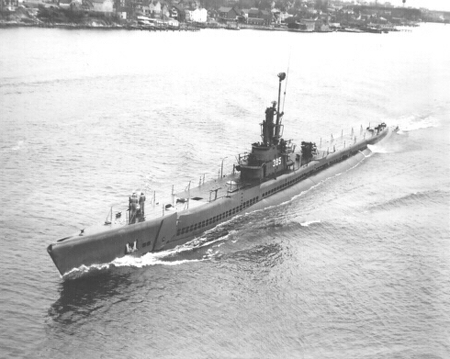USS BANG - SS 385




Sentry of the Seas
|
USS Bang
The three subs coordinated contact information and attack plans throughout the patrol. On 29 April, BANG sighted a 12 ship convoy southbound in the traffic lanes. After maneuvering into a favorable position, BANG fired her torpedoes into the convoy, sinking a cargo ship, the Takeqawa Maru. The submarine continued to hound the convoy during the night, and in the morning of the 30th, succeeded in sinking another freighter, Nittatsu Maru. The enemy depth charges rained on BANG, but her training in evasive maneuvers helped her to escape damage. TINOSA sighted a northbound convoy on 3 May, and BANG moved in to pursue the 10 Japanese ships. Her first attempt to attack during daylight was foiled by enemy plane and surface escorts who forced her to dive. After dark, BANG and the other two subs coordinated a surface attack in which BANG sank a large cargo ship; the Kinrei Maru, and claimed the destruction of a destroyer which postwar records do not credit the sub. Since all of her torpedoes were expended, BANG departed the area on 6 May and arrived at Midway on the 14th for refit alongside Proteus (AS-19). BANG put to sea for her second war patrol on 6 June. She was initially assigned to an open sea area to the westward of the Marianas Islands and to intercept any reinforcing Japanese units steaming eastward. While enroute to her station, the sub encountered a lone northbound tanker on 14 June. Although hampered by heavy rain squalls and turbulent seas, BANG loosed a spread of three torpedoes, one of which hit the target causing some damage but not sinking her. The sub was unable to finish off her target because she was ordered to proceed to her assigned station as soon as possible.
BANG spent an uneventful week on station, then moved to her patrol area on 22 June, where she rendezvoused with GROWLER (SS-215) and SEAHORSE (SS-304) off Formosa and formed a wolfpack. GROWLER was detached just one day prior to the pack's run-in with a southbound convoy of over 15 ships. BANG made a periscope attack and fired ten torpedoes at three overlapping targets, all of which the submarine claims to have sunk, although the postwar records do not confirm this claim. The enemy escorts turned and pursued BANG, dropping 125 depth charges over the sub as it went deep to avoid destruction. When the sub finally surfaced, the convoy was moving over the horizon. On 4 July, BANG sighted a small Hong Kong bound convoy consisting of one cargo ship and four destroyer escorts. The sub approached the convoy on the surface, but before she could maneuver into the best position for firing, an alert escort began to search for the attacker. BANG fired three torpedoes without making adequate attack solutions, and all three missed their targets. The sub was forced to dive and maneuver to avoid the depth charges dropped by the escort, and was unable to mount another attack on the convoy. BANG's patrol was terminated and on 17 July, she headed back to Pearl Harbor for refit, which was completed during the last week of August. She left Pearl Harbor again on her third war patrol 27 August, refueled at Midway on 31 August, and continued to her patrol area northeast of Formosa off the Nansei Shoto. While passing northwest of the Bonin Islands to take up her station, BANG encountered an enemy convoy on 9 September. Diving to make a periscope attack, BANG fired a salvo at two loaded freighters, both of which -- the Tokiwasan Maru and Shoryu Maru -- disintegrated due to internal explosions triggered by the hits. The escorts evidently sighted BANG's periscope and torpedo wakes, because as she dove deep, the depth charges accurately drove her down beyond her test depth to 580 feet where depth control was almost lost. A pattern of 16 charges exploded directly over the boat, but BANG out-waited her enemy. The escorts departed to report the sub-kill, but BANG was able to surface and continue to trouble enemy shipping. Only minor damage was incurred and easily repaired by the crew. Three days later, the sub arrived on station. Early on 19 September, BANG made radar contact on another enemy convoy. The submarine submerged and fired on two cargo transports. The Tosei Maru No. 2 sank while the other ship suffered substantial damage. Three enemy escorts working as a team systematically depth bombed the sub but again BANG successfully out-maneuvered her pursuers and surfaced after dark. The submarine contacted an eastbound convoy while submerged on the afternoon of 20 September and shadowed it until the cover of darkness allowed her the best advantage for attack. She surfaced and fired her remaining ten torpedoes and claims to have sunk a large tanker and a medium freighter as well as damaging another. The next day, she departed the area for refit at Midway. Repaired, refueled, and replenished, BANG departed Midway on 25 October and returned to the same patrol area, but with SHAD (SS-235) and REDFISH (SS-395) as the other subs in the wolfpack. Typhoon weather hampered effective patrol during the early part of the fourth war patrol. Improved weather conditions on 22 November gave BANG the opportunity to attack a convoy initially reported by REDFISH. Between midnight and 0300 on the 23rd, all three subs conducted coordinated attacks on the convoy. BANG fired all 24 of her torpedoes in a series of seven surface attacks, sinking two cargo ships -- Sakae Maru and Amakusa Maru -- and unofficially sinking a minelayer escort and another freighter. Between the three submarines, the convoy was totally destroyed. BANG departed the area on 23 November and arrived at Pearl Harbor on 5 December for refit. |
 Commanding Officers
Commanding Officers